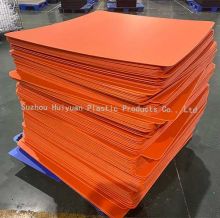©Copyright 2019 Suzhou Huiyuan Plastic Products Co., Ltd All rights reserved. Terms and Conditions Designed by iwonder.cnSite Map
In modern packaging and logistics, layer pads play a crucial yet often overlooked role. Whether you're in the beverage industry, manufacturing, agriculture, or e-commerce, layer pads contribute significantly to load stability, hygiene, and cost-efficiency. But what exactly is a layer pad? What types exist, and how do they benefit your operations?
In this comprehensive guide, we’ll explore everything you need to know about layer pads, especially plastic layer pads, corrugated plastic layer pads, PP layer pads, and their applications in palletizing and storage.

A layer pad is a thin, flat sheet placed between layers of stacked goods—typically on a pallet—to protect products during transportation and storage. It provides stability, prevents product slippage, and shields items from dirt, dust, or moisture.
Layer pads are commonly used to:
Separate layers of bottles, cans, or boxes on a pallet
Provide structural support for stacked items
Prevent abrasion and physical damage
Enhance stacking efficiency
They are widely applied across industries such as:
Food & beverage
Pharmaceuticals
Chemicals
Electronics
Warehousing and logistics
Layer pads come in different materials and designs, depending on specific use cases. The most common types include:
Traditionally made from corrugated cardboard, these pads are cost-effective and biodegradable but lack water resistance and durability. They are suitable for light-duty or single-use applications.
Plastic layer pads have become the go-to option for companies seeking reusable, durable, and moisture-resistant solutions. These include:
PP layer pads are made from virgin or recycled polypropylene. They offer:
Excellent resistance to chemicals
High stiffness and impact strength
Long service life (can be reused hundreds of times)
Also known as twin-wall plastic sheets, these are lightweight, water-resistant, and easy to clean. Corrugated plastic layer pads consist of two flat plastic sheets separated by vertical ribs, creating a structure that’s both strong and light.
These are heavy-duty plastic pads specifically designed to be used with pallets. Their precise dimensions and robust build ensure perfect alignment on pallets for automated or manual stacking.
Here are the most notable advantages of using plastic-based layer pads:
Unlike cardboard, plastic layer pads do not absorb water, making them ideal for cold storage, wet environments, or clean rooms. They also resist chemicals and oils, useful in industrial applications.
High-quality plastic layer pads can last for years and withstand hundreds of use cycles. This reduces packaging waste, lowers total packaging cost over time, and supports green logistics goals.
Plastic is non-porous and easy to disinfect. This makes plastic pallet layer pads perfect for applications requiring strict hygiene—such as food or pharma supply chains.
Corrugated plastic layer pads strike the perfect balance between weight and strength, reducing overall pallet load without compromising protection.
Manufacturers can tailor layer pads to customer needs:
Thickness: 2mm–10mm
Color: black, blue, gray, white, or custom
Surface: smooth, embossed, or anti-slip
Size: according to pallet or product dimensions
Printing: branding or handling instructions
Here’s how different industries utilize layer pads:
▪ Beverage Industry
Used to separate layers of bottles or cans in crates or on pallets. PP layer pads help prevent abrasion and product shifting during transport, ensuring safe delivery and reducing damage rates.
▪ Food Industry
Plastic layer pads are used in meat processing, dairy storage, and bakeries to separate food trays or bins, ensuring hygiene, preventing cross-contamination, and maintaining structural integrity.
▪ Warehousing & Logistics
Layer pads simplify palletizing operations, support heavy items, optimize vertical space usage, and improve overall warehouse efficiency by stabilizing stacked loads.
▪ Electronics & Appliances
Non-conductive plastic layer pads protect sensitive parts from vibration, static, and electrostatic discharge, helping maintain product quality during shipment.
▪ Agriculture
In greenhouses or seedling trays, layer pads are used as separators or as part of propagation trays, promoting better air circulation and protecting fragile plants.
When selecting layer pads for your business, consider the following factors:
Choose PP or PE for maximum durability and reusability.
Use corrugated plastic if weight reduction is a priority.
For cold storage or wet areas, plastic layer pads are essential.
In dry environments, recyclable cardboard pads might suffice.
If you need reusable pads, invest in plastic pallet layer pads that offer long-term performance.
Heavier items require thicker or reinforced layer pads.
Lightweight items can use thin, corrugated pads.
While plastic pads cost more upfront, they are cost-effective over time and align with sustainable packaging strategies.
| Feature | Cardboard | Corrugated Plastic | Solid Plastic (PP) |
|---|---|---|---|
| Water Resistance | Poor | Good | Excellent |
| Durability | Low | Medium | High |
| Reusability | No | Yes (moderate) | Yes (extensive) |
| Cleanability | No | Yes | Yes |
| Cost per Unit | Low | Medium | High |
| Eco-Friendliness | Biodegradable | Recyclable | Recyclable |
Businesses around the world are moving away from cardboard to adopt more durable, efficient plastic alternatives. Here’s why:
Reduction in product damage
Savings on packaging costs over time
Cleaner, safer, and more consistent stacking
Compliance with hygiene and quality standards
If you operate in a sector where product integrity and cleanliness are key, plastic pallet layer pads are not just an upgrade—they’re a necessity.
Layer pads are essential components in the modern supply chain. Whether you're transporting bottles, storing electronics, or organizing pallets, choosing the right layer pad ensures product protection, efficiency, and cost-effectiveness.
From corrugated plastic layer pads to heavy-duty plastic pallet layer pads, the right solution can significantly improve your logistics performance while supporting your environmental goals.
Need high-quality plastic layer pads or PP pallet pads for your business?
We are a professional manufacturer of plastic pallet layer pads and stackable packaging solutions, offering customized designs to suit your industry needs.
Contact us at: hy331@huiyuansj.cn
Phone: +86 15262350494
Visit our website: https://www.huiyuansjplastic.com/
Let us help you optimize your packaging and logistics operations today!
By continuing to use the site you agree to our privacy policy Terms and Conditions.